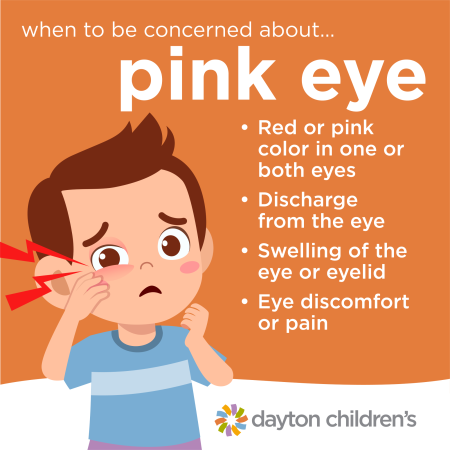4/26/23 blog post
when to be concerned about pink eye

in this article:
Pink eye, or conjunctivitis, is a common eye infection that impacts both kids and adults. It’s one of the most common eye problems among kids causing 3 million missed days of school a year, according to the Centers for Disease Control and Prevention. As a parent, it's important to know the symptoms of pink eye and how to prevent its spread, as it is highly contagious and can easily be passed on from one person to another.
what is pink eye?
Pink eye is a common term used by parents and health care providers to describe the red eyes that children can frequently have throughout childhood. These can be infections (bacteria or viruses) or environmental irritants (airborne allergies or chlorine from swimming).
what is the difference between bacterial and viral pink eye?
Conjunctivitis, or pink eye, can be caused by bacteria or viruses. Viruses are more common by far, and usually involve one or both eyes being red, with minimal discharge. Numerous common cold viruses can cause the eyes to be pink or red. Adenovirus can cause outbreaks of pink eye in daycare and schools.
The hallmark of bacterial conjunctivitis is sticky discharge, frequently matting the eyes shut. After cleaning, the discharge returns quickly.
what are the symptoms of pink eye?
Children with viral pink eye may only have red or pink eyes but can also have common cold symptoms, like congestion and cough. Children with bacterial pink eye have thick discharge in their eyes, frequently requiring warm compresses to open the eyes.
how is pink eye treated?
Viral pink eye can usually be treated at home by gently cleaning the eyes with moist cotton balls or clean cloths. It usually resolves in a few days.
Bacterial pinkeye is more persistent with discharge re-accumulating quickly. This infection will usually require an antibiotic prescribed by a health care provider.
how long is a child contagious if they have pink eye?
Viral pink eye is considered contagious while the child has pink eyes. They are frequently contagious 24 hours before their symptoms develop. Like most viruses, the symptoms can continue for 5 to 7 days.
Bacterial pink eye is contagious while children have symptoms but are considered able to return to their activities after 24 hours of initiating a prescribed antibiotic to treat their eyes.
should you keep your child home if they have pink eye? when can they go back to activities?
When to return to activities is always a difficult question after your child is ill. If your child needs your care, they probably need to stay home. Children with viral pink eye usually feel okay. Smaller daycare providers may be able to allow children with limited care needs for their illness or pink eye to return to the daycare setting, especially if the children there have all been exposed to that child already.
Larger facilities and schools may want resolution of symptoms or clear eyes before return.
Admittedly, since it is often difficult to distinguish early on if a pink eye is bacterial or viral, it is not uncommon for children with limited symptoms to be started on antibiotic treatment for their eye infections, simply to allow their return to daycare, school and activities.
what to do if you think your child has pink eye
If you suspect your child has pink eye, you can make an appointment with their pediatrician to get confirmation and a treatment plan. If your child's pediatrician is unavailable, you can save your spot for a visit at one of Dayton Children’s four Kids Express locations in Beavercreek, Mason, Springboro or West Chester.


